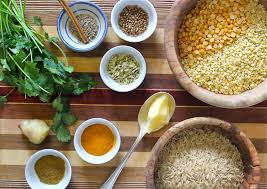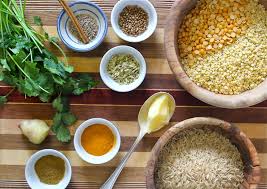 Ask Ayurveda:
Ask Ayurveda:
“I am curious about detoxing and Ayurveda. I try to do a cleanse at least twice a year, and in the past I have typically done either juice fasts or even water fasts. I recently saw an Ayurvedic practitioner in my area and they assessed that I was a Vata type. I have since read more on Vata body-types and it seems like raw juice fasting is not recommended for me. I guess it makes sense since I get really spacey, lethargic, gassy, and constipated during the juice fasts. It is great that I learned this information, but now I am looking to do a cleanse in the near future. What is the best Ayurvedic cleanse for Vata types? I work a lot, so I hopefully can sustain my energy during the cleanse as much as possible!” Detox Dilemma
Dear Detox Dilemma:
As an Ayurvedic practitioner, I get asked about cleanses and detoxes all the time; and yes, each individual will require different methods to fit their body-type and personal needs. It is very true that I would never recommend a liquid fast of any kind for Vata types. It is of no surprise that you have become lethargic, gassy, and constipated during your previous juice fasts, as Vata types need more substance even during cleanses. I actually rarely ever recommend liquid fasts to any-body, except occasionally Kapha types very seldom.
A healthy Ayurvedic cleanse is of three parts: the pre-cleanse, the actual cleanse, and the post-cleanse; these will be essential for any body-type. The difference with Vata is they tend towards constipation, lightness, anxiety, and dryness; so it is very important that we do not provoke any of these factors during the cleanse. An Ayurvedic cleanse is typically of a mono-diet (one-food diet), consisting of the traditional Indian dish known as kitchari (mung dal with basmati rice). However, this dish can be modified to fit the needs of the individual. Read more on the Ayurvedic Kitchari Cleanse here.
An Ayurvedic cleanse has many other components rather than just dietary. They typically utilize herbal formulas, medicated ghee and lots of oil (external and internal). It is impossible for me to evaluate you without a full Ayurvedic consultation, but for simplicity of this article here are some general recommendations for a Vata-friendly detox program*.
*Since the fall is the season of Vata, these recommendations will be beneficial for all body-types during the fall.
General Tips for a Vata Detox Program
1. Modify the kitchari to fit Vata’s digestive needs.
Vata type’s may need to use brown rice (instead of basmati) and/or whole mung beans (instead of split) which will help to add bulk to the mono-diet and avoid constipation during the cleanse. Some other healthy additions include using grounding root veggies such as beets, carrots, and sweet potato, Vata-reducing spices, and of course lots and lots of ghee or sesame oil.
Get our Vata Kitchari recipe here!
2. Use a lot of Ghee!
This is very important for all three stages of the cleanse. The pre-cleanse and cleanse itself should consist of the Tikta Ghria or Triphala Ghrita in the mornings to lubricate and cleanse the GI tract. Plain ghee should also be added generously to each meal during the entire cleanse which will aid in promoting elimination and digestion. During the post-cleanse you can take either plain ghee with honey each day or even better, the Rejuvenation Ghee formula with honey. This ghee is good for all body-types, but especially Vata!
3. Use lots of digestive spices.
Spices are a great addition in all Ayurvedic cleanses to help boost the digestive fire, aid in elimination, and increase detoxification. The best spice options for Vata will be fresh ginger, turmeric, black pepper, fenugreek, cumin, brown mustard seed, black cumin, hing, ajwain, pink Himalayan salt, and mineral salt.
4. Drink bone broth throughout the cleanse.
Bone broth is an excellent tonic for Vata, yet simple enough to take during a cleanse. If you are performing a cleanse and are worried about not having enough energy to make it through your days, this is a great addition for increasing nourishment and nutrients. You can drink this either between meals or even use it as a base for the kitchari recipe (in replacement of water). Bone broth is also useful in preventing constipation and creating lubrication, inside and out!
Click here for our Ayurvedic Bone Broth recipe.
5. Drink calming herbal tea.
To keep Vata balanced during the cleanse, I would recommend taking a soothing tea blend each day of the cleanse. This will help to calm Vata, but also herbal teas are great additions to any cleanse to help boost digestive and enhance detoxification. These teas work on calming anxiety and reducing stress which are essential emotional factors to work on during any cleanse!
6. Apply oil to the body daily.
This is an important recommendation for any Ayurvedic cleanse, but especially for Vata types. The Ayurvedic self-massage should be performed each night before bed, even during the pre-cleanse phase. Vata Massage Oil is the best option, as it is infused with the most powerful Vata-pacifying herbs, but if this is not available organic sesame oil is the next best option.
7. Take a ginger baking soda bath each night.
Sweating is a great way to boost a detox program. An amazing method for this is the ginger baking soda bath, which not only promotes detoxification via the sweat glands, but also reduces stress and tension as it calms on the nervous system (and therefore Vata). Try to take a ginger baking soda bath each night- before and during the cleanse.
Get our Ginger Detox Bath recipe here.
8. Take 1 to 2 tablespoons of Sat Isabgol before bed each night.
Sat Isabgol, better known as psyllium husk, is a great addition for a Vata cleanse program to prevent issues with constipation. Sat Isabgol is great for adding fiber to the diet, promoting lubrication and bulk in the colon. If you do take this however, make sure to drink lots of warm water throughout the day, as it has a tendency to create dryness if enough water is not taken with it.
9. Perform an herbal enema during the cleanse.
The herbal enema, known as Basti in Ayurveda, is the number one protocol for a traditional Vata cleanse program. The herbal enema can be performed 1 to 3 times during the cleanse and is a great way to pacify Vata in its “home-base”, the colon. A variety of herbs can be used to make the tea for the enema, but the best option is by far Dashamul, especially for Vata imbalances. This procedure is a very powerful method for reducing dryness, anxiety, sleep issues, constipation, and gas during the cleanse and beyond.
So Detox Dilemma, now you have some general recommendations for performing a safe and healthy Ayurvedic cleanse for Vata types. Please also keep in mind that a cleanse can be of different intensities; the deeper you want to go, the more of these recommendations you should follow to stay in balance while getting the most out of your cleanse.
I do have one last recommendation before I say good bye. Any cleanse or detox is a reducing measure, and therefore the energy will become depleted during this time. This means that it is important to not do too much activity of any kind during the cleanse; including working, school, vigorous exercise, intense yoga, excessive social activities, and being in “extreme” elements such as direct sun, intense cold, or extreme winds for too long. If you over do yourself in a cleanse, more harm can manifest rather than the healing you are intending on establishing. I cannot stress this enough, especially for the sensitive Vata types!
Whatever you decide, please plan intelligently and always listen to your body. A cleanse can be extremely healing or it can be excessively depleting, depending on the administration. That is why it is generally recommended to perform cleanses with the guidance of a knowledgeable holistic practitioner. Feel free to contact me with questions or to let me know how it goes. I will be really curious to hear how it compares to your previous juice cleanses!
Namaste,
Ask Ayurveda


